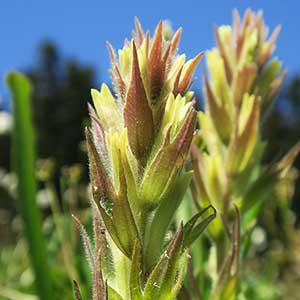Castilleja cryptantha
Castilleja gracillima
Mt. Rainier or obscure paintbrush, obscure Indian paintbrush, obscure paintbrush
slender Indian paintbrush, slender paintbrush
few to several, erect or ascending, unbranched, hairs spreading, long, soft, eglandular, mixed with short stipitate-glandular ones.
solitary, sometimes few, proximally creeping, becoming rhizomatous, erect to ascending distally, unbranched, sometimes branched, often glabrate proximally, hairy distally, hairs spreading, medium length and long, soft, mixed with much shorter stipitate-glandular ones near inflorescence.
green, often with brown or purple veins, narrowly to broadly lanceolate, 1.5–4 cm, not fleshy, margins plane, ± involute, 0–3-lobed, apex acute to acuminate;
lobes spreading-ascending, narrowly lanceolate, apex acute to ± obtuse.
green to purplish, linear-lanceolate to broadly lanceolate or narrowly oblong, 1.2–7.1 cm, not fleshy, margins plane, sometimes ± wavy, slightly involute, 0-lobed, apex acute to acuminate.
(2.5–)3–6 × 1–2 cm; green to dull brown or dull reddish purple throughout, or proximally green to dull brown or dull reddish purple, distally yellow on apices, broadly lanceolate to ovate, (0–)3-lobed;
lobes ascending, narrowly lanceolate, long or short, arising near mid length, apex acute or acuminate.
4.5–18 × 1.5–6 cm;
bracts white, cream, pale yellow, pink, salmon, orange, or dull red throughout, or proximally greenish, distally as above, broadly lanceolate to oblong, 0–3(–5)-lobed;
lobes ascending to erect, lanceolate to triangular, often short, arising above mid length, apex obtuse or rounded, sometimes acute or acuminate.
straight, 14–16 mm;
tube 11–14 mm;
whole corolla included within calyx;
beak adaxially pale yellow, 1–2 mm;
abaxial lip deep green, slightly inflated, 4–5 mm, 67% as long as beak;
teeth ascending, pale, 1.5–2 mm.
± straight, 19–30 mm;
tube 11–19 mm;
beak exserted from calyx, adaxially green, 7.5–11 mm;
abaxial lip deep green, reduced, 1–2 mm, 20% as long as beak;
teeth incurved to erect, green, 0.5–1 mm.
proximally green or pale with green veins, lobes yellow, sometimes becoming deep red with age, 12–15 mm;
abaxial and adaxial clefts 3–7 mm, 25–50% of calyx length, deeper than laterals, lateral 1–3(–4) mm, 8–20% of calyx length;
lobes triangular, adaxial segments longer than abaxials, apex acute or obtuse.
colored as bracts, pigmentation often confined to lobes, 15–22 mm;
abaxial and adaxial clefts 7–14 mm, 40–50% of calyx length, deeper than laterals, lateral 2–6.5 mm, 10–20% of calyx length;
lobes narrowly triangular to narrowly lanceolate, apex acute (to sometimes acuminate in Logan Valley).
= 24.
= 48.
Castilleja cryptantha
Castilleja gracillima
Castilleja cryptantha is endemic to the vicinity of Mt. Rainier in the Cascade Range, with most populations found within Mt. Rainier National Park. Unlike most species of Castilleja, it is apparently self-pollinating (W. J. Duffield 1972); the small flowers are entirely enclosed within the yellowish calyces, which tend to grow deep reddish as they age. The purplish brown bracts are also unusual in the genus.
(Discussion copyrighted by Flora of North America; reprinted with permission.)
Castilleja gracillima populations are centered around the Greater Yellowstone region, but its range extends sporadically west to central Oregon. It is sometimes confused with C. miniata, but differs from that species in its floral dimensions, mostly single-stemmed growth form, primarily white, yellow, or pinkish orange bract coloration, puberulent stems, and weakly rhizomatous habit. Where the two grow in the same general region, there is no clear evidence of hybridization; however, C. cusickii and C. gracillima form an extensive, sporadically intergrading population in the Logan Valley, Grant County, Oregon.
Plants attributed to this species from the Rocky Mountain trench near the head of the Columbia River in southeastern British Columbia or adjacent Alberta are a combination of several other species, especially Castilleja lutescens and C. miniata.
(Discussion copyrighted by Flora of North America; reprinted with permission.)


